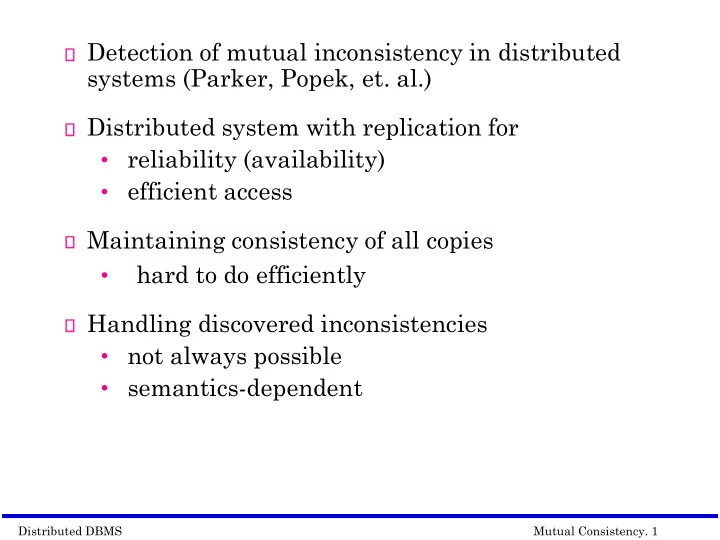

Detection of mutual inconsistency in distributed systems (Parker, Popek, et. al.) Distributed system with replication for • reliability (availability) • efficient access Maintaining consistency of all copies hard to do efficiently • Handling discovered inconsistencies • not always possible • semantics-dependent Distributed DBMS Mutual Consistency. 1
Tradeoffs between degree of replication of objects versus access time of object availability of object (during partition) synchronization of updates (overhead of consistency) All objects should always be available. All objects should always be consistent. “Partitioning can destroy mutual consistency in the worst case”. Basic Design Issue: Single failure must not affect entire system (robust, reliable). Distributed DBMS Mutual Consistency. 2
Previous work • Maintain consistency by: − Voting (majority consent) − Tokens (unique/resource) − Primary site (LOCUS) − Reliable networks (SDD-1) − Disk toking Prevent inconsistency at a cost does not address detection or resolution issues. Want to provide availability and correct propagation of updates. Distributed DBMS Mutual Consistency. 3
Detecting Inconsistency Network may continue to partition or partially merge for an unbounded time. Semantics also different with replication: naming, creation, deletion… names in on partition do not relate to entities in another Need globally unique system name, and user name(s). Must be able to use in partitions. Distributed DBMS Mutual Consistency. 4
System name consists of a < Origin, Version > pair • Origin – globally unique creation name • Version – vector of modification history • Two types of conflicts: Name – two files have same user-name • Version – two incompatible versions of the same file. Different • mod. Histories (not initial history) Conflicting files may be identical… Semantics of update determine action Detection of version conflicts Timestamp – overkill • Version vector – “necessary + sufficient” • Update log – need global synchronization • Distributed DBMS Mutual Consistency. 5
Version vector approach each file has a version vector (S i : u i ) pairs S i – site file is resident upon u i - # updates on that site Example : < A:4, B:2; C:0; D:1 > Compatible vectors: one is at least as large as the other over all sites in vector < A:1; B:2; C:4; D:3 > ← < A:0; B:2; C:2; D:3 > < A:1; B:2; C:4; D:3 > < A:1; B:2; C:3; D:4 > (< A:1; B:2; C:4; D:4 >) Distributed DBMS Mutual Consistency. 6
Committed updates on site S i update u i by one Deletion/Renaming are updates, leave zero-length file (?) Remove file if all versions zero Resolution on site S i increments u i to maintain consistency later. to Max S i Storing at new site makes vector longer by one site. Still compat. (vectors may grow and shrink) Inconsistency determined as early as possible. Only works for single file consistency, not transactions… Distributed DBMS Mutual Consistency. 7
A B C < A:0 B:0 C:0 > < A:0 B:0 C:0 > < A:2 B:0 C:0 > A B C A updates f twice < A:3 B:0 C:0 > A B C < A:2 B:0 C:1 > B’s version adopted A updates f once CONFLICT A B C 3 > 2, 0 = 0, 0 < 1 Version vector VV i = (S i ; v i ) v i update to file f at site S i Distributed DBMS Mutual Consistency. 8
A B C D + A B C D + : update D + + A B C B C D A B C D Distributed DBMS Mutual Consistency. 9
A B C D < A:0, B:0, C:0, D:0 > < A:2, B:0, C:0, D:0 > + < A:0, B:0, C:0, D:0 > A B C D < A:0, B:0, C:0, D:0 > D A B C + + < A:2, B:0, C:1, D:0 > < A:3, B:0, C:0, D:0 > B C D < A:2, B:0, C:1, D:0 > A B C D CONFLICT! After reconcilation at site B < A:3, B:1, C:1, D:0 > Distributed DBMS Mutual Consistency. 10
Resolution of Conflicts Semantics-Dependent Automatic resolution desirable, where possible: Mailbox, Directory (R/W) Only two types of object update (R/W) Simple union/intersection works Other Scenarios: • Credits and Debits x + i (x) in each partition x + i (x) after merge May have to constrain i (x) to prevent overdraft • Airline Reservations Distributed DBMS Mutual Consistency. 11
General resolution rules not possible. External (irrevocable) actions prevent reconciliation, rollback, etc. Resolution should be inexpensive. System must address: detection of conflicts (when, how) • meaning of a conflict (accesses) • resolution of conflicts • – automatic – user-assisted Distributed DBMS Mutual Consistency. 12
Conclusions Effective detection procedure • providing access without mutual • exclusion (consent). Robust during partitions (no loss). Occasional inconsistency tolerated for the sake of availability. Reconciliation semantics… Recognize dependence upon semantics. Distributed DBMS Mutual Consistency. 13
Recommend
More recommend